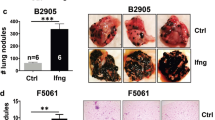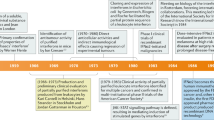Abstract
Primary tumor growth and metastasis depend on angiogenesis, which is determined by the balance between proangiogenic and antiangiogenic molecules. Interferon (IFN)-α and -β inhibit angiogenesis through downregulation of interleukin-8, matrix metalloproteinase-9, and basic fibroblast growth factor. To provide evidence for the causal role of IFN-α/β in the induction of neoplasms, their angiogenesis, and hence, progressive growth, we carried out experiments using 129S6 IFN-α/β receptor −/− mice back-crossed to BALB/c nude mice. Subcutaneous angiogenesis was determined following implantation of gelfoam sponges containing 0.4% agarose and several proangiogenic molecules. Tumorigenicity and production of lung metastasis were determined subsequent to subcutaneous and intravenous injections, respectively, of highly metastatic A375SM human melanoma cells. Carcinogenesis was induced by chronic exposure of mice to UVB radiation (5 kJ/m2, 3 times/week). Angiogenesis, tumorigenicity, and production of metastasis, as well as development of autochthonous skin tumors, were all accelerated in IFN-α/β receptor −/− mice as compared to control mice. Collectively, the data show that inability to respond to endogenous IFN-α/β (through a mutation in the IFN-α/β receptor) leads to increased susceptibility to carcinogenesis, enhanced angiogenesis, tumorigenicity, and metastasis.
Similar content being viewed by others
References
Fidler IJ. Cancer biology: invasion and metastasis. In Abeloff MD, Armitage JO, Lichter AS, Niederhuber JE (eds): Clinical Oncology, 2nd edition. New York: Churchill Livingstone 2000; 29–53.
Fidler IJ, Yano S, Zhang R et al. The seed and soil hypothesis: vascularization and brain metastases. Lancet 2002; 3: 53–7.
Fidler IJ, Singh RK, Yoneda J et al. Critical determinants of neoplastic angiogenesis. Cancer J Sci Am 2000; 6: S225–36.
Volpert OV, Lawler J, Bouck NP. A human fibrosarcoma inhibits systemic angiogenesis and the growth of experimental metastases via thrombospondin-1. Proc Natl Acad Sci USA 1998; 95: 6343–8.
Streit M, Velasco P, Brown LF et al. Overexpression of thrombospondin-1 decreases angiogenesis and inhibits the growth of human cutaneous squamous cell carcinomas. Am J Pathol 1999; 155: 441–52.
O'Reilly MS, Boehm T, Shing Y et al. Endostatin: An endogenous inhibitor of angiogenesis and tumor growth. Cell 1997; 88: 277–85.
Stark GR, Kerr IM, Williams BR et al. How cells respond to interferons. Ann Rev Biochem 1998; 67: 227–64.
Gresser I. On the varied biologic effects of interferon. Cell Immunol 1977; 34: 406–15.
Clemens MJ, McNurlan MA. Regulation of cell proliferation and differentiation by interferons. Biochem J 1985; 226: 345–60.
Haque SJ, Williams BR. Signal transduction in the interferon system. Semin Oncol 1998; 25: 14–22.
Takaoka A, Mitani Y, Suemori H et al. Cross talk between interferon-γ and-α/β signaling components in caveola membrane domains. Science 2000; 288: 2357–60.
Sidky YA, Borden EC. Inhibition of angiogenesis by interferons: effects on tumor-and lymphocyte-induced vascular responses. Cancer Res 1987; 47: 5155–61.
Bielenberg DR, Fidler IJ, Bucana CD. Constitutive expression of interferon beta in differentiated epithelial cells exposed to environmental stimuli. Cancer Biother Radiopharm 1998; 13: 375–82.
De Maeyer-Guignard J, De Maeyer E. Immunomodulation by interferons: Recent developments. Interferon 1985; 6: 69–91.
Singh RK, Gutman M, Bucana CD et al. Interferons alpha and beta downregulate the expression of basic fibroblast growth factor in human carcinomas. Proc Natl Acad Sci USA 1995; 92: 4562–6.
Singh RK, Gutman M, Llansa N, Fidler IJ. Interferon-β prevents the upregulation of interleukin-8 expression in human melanoma cells. J Interferon Cytokine Res 1996; 16: 577–84.
Oliveira IC, Sciavolino PJ, Lee TH, Vilcek J. Downregulation of interleukin 8 gene expression in human fibroblasts: unique mechanism of transcriptional inhibition by interferon. Proc Natl Acad Sci USA 1992; 89: 9049–53.
Kato N, Nawa A, Tamakoshi K et al. Suppression of gelatinase production with decreased invasiveness of choriocarcinoma cells by human recombinant interferon-β. Am J Obstet Gynecol 1995; 172: 601–6.
Mintzer RJ, Croze E, Rubanyi GM et al. Differential effects of IFN-β 1b on the proliferation of human vascular smooth muscle and endothelial cells. J Interferon Cytokine Res 1998; 18: 939–45.
Bielenberg DR, Bucana CD, Sanchez R et al. Progressive growth of infantile cutaneous hemangiomas is directly correlated with hyperplasia and angiogenesis of adjacent epidermis and inversely correlated with expression of the endogenous angiogenesis inhibitor, IFN-β. Int J Oncol 1999; 14: 401–8.
Wineland M, Ahearne P, Bielenberg D et al. Mclanoma-induced epidermal hyperplasia increases angiogenesis of the lesion Proc Am Assoc Cancer Res 1998; 39: 375–6 (Abstr).
Kuniyasu H, Yasui W, Shinohara H et al. Induction of angiogenesis by hyperplastic colonic mucosa adjacent to colon cancer. Am J Pathol 2000; 157: 1523–35.
Huang S, Hendriks W, Althage A et al. Immune response in mice that lack the interferon-gamma receptor. Science 1993; 259: 1742–5.
Muller U, Steinhoff U, Reis LF et al. Functional role of type I and type II interferons in antiviral defense. Science 1994; 264: 1918–21.
Steinhoff U, Muller U, Schertler A et al. Antiviral protection by vesicular stomatitis virus-specific antibodies in α/β interferon receptor-deficient mice. J Virol 1995; 69: 2153–8.
van den Broek MF, Muller U, Huang S et al. Immune defense in mice lacking type I and/or type II interferon receptors. Immunol Rev 1995; 148: 5–18.
Donawho CK, Wolf P, Kripke ML. Enhanced development of murine melanoma in UV-irradiated skin: UV dose response, waveband dependence, and relation to inflammation. Melanoma Res 1994; 4: 93–100.
Kozlowski JM, Hart IR, Fidler IJ et al. A human melanoma line heterogeneous with respect to metastatic capacity in athymic nude mice. J Natl Cancer Inst 1984; 72: 913–7.
McCarty MF, Baker CH, Bucana CD, Fidler IJ. Quantitative and qualitative in vivo angiogenesis assay. Int J Oncol 2002; 21: 5–10.
Weidner N, Semple JP, Welch WR et al. Tumor angiogenesis and metastasis — correlation in invasive breast carcinoma. N Engl J Med 1991; 324: 1–8.
Eggermont AM. The role interferon-alpha in malignant melanoma remains to be defined. Eur J Cancer 2001; 37: 2147–53.
Kimyai-Asadi A, Usman A. The use of interferon alfa as adjuvant therapy for advanced cutaneous melanoma: the need for more evidence. J Am Acad Dermatol 2000; 43: 708–11.
Garbe C, Krasagakis K. Effects of interferons and cytokines on melanoma cells. J Invest Dermatol 1993; 100: 239S–44S.
Bielenberg DR, Bucana CD, Sanchez R et al. Molecular regulation of UVB-induced cutaneous angiogenesis. J Invest Dermatol 1998; 111: 864–72.
Bolontrade MF, Stern MC, Binder RL et al. Angiogenesis is an early event in the development of chemically induced skin tumors. Carcinogenesis 1998; 19: 2107–13.
Larcher F, Robles AI, Duran H et al. Upregulation of vascular endothelial growth factor/vascular permeability factor in mouse skin carcinogenesis correlates with malignant progression state and activated H-ras expression levels. Cancer Res 1996; 56: 5391–6.
Author information
Authors and Affiliations
Rights and permissions
About this article
Cite this article
McCarty, M.F., Bielenberg, D., Donawho, C. et al. Evidence for the causal role of endogenous interferon-α/β in the regulation of angiogenesis, tumorigenicity, and metastasis of cutaneous neoplasms. Clin Exp Metastasis 19, 609–615 (2002). https://doi.org/10.1023/A:1020923326441
Issue Date:
DOI: https://doi.org/10.1023/A:1020923326441




